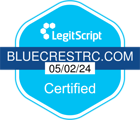Dealing with the complexities of co-occurring mental health and substance use disorders can be incredibly challenging for those on the path to recovery. It’s not uncommon for anxiety disorders to intensify substance use issues, creating a distressing cycle that can feel overwhelming.
In this article, we strive to offer a compassionate and thorough understanding of the various types of anxiety disorders, their symptoms, and the most effective treatments available. By delving into the complex relationship between anxiety and substance misuse and highlighting the importance of integrated treatment plans, we hope to support individuals in finding the help and care they need.
Together, we can make the journey to recovery a little less challenging and a lot more hopeful.
What Is an Anxiety Disorder?
Anxiety disorders fall under mental health conditions characterized by excessive anxiety, worry, and fear. While occasional anxiety is a normal response to stress, anxiety disorders involve more constant worries that interfere with daily activities.
What Are the Signs of Anxiety Disorders?
Anxiety disorders can present themselves in many forms, frequently impacting both mental and physical well-being. Common symptoms include:
- Nervousness or restlessness
- Increased heart rate
- A persistent feeling of imminent danger, panic, or doom
- Rapid breathing (hyperventilation)
- Trembling or sweating
- Weakness or fatigue
- Difficulty concentrating
- Gastrointestinal problems, such as irritable bowel syndrome
- Trouble sleeping
- Avoidance of anxiety-triggering situations
These symptoms can be debilitating, leading people with anxiety disorders to seek relief through various means, including substance use.
Types of Anxiety Disorders
Generalized Anxiety Disorder (GAD)
Generalized Anxiety Disorder (GAD) involves chronic anxiety, exaggerated worry, and tension, even when there is little or nothing to provoke it. People with GAD often anticipate disaster and may experience physical symptoms like heart palpitations and rapid heartbeat.
Social Anxiety Disorder
Social Anxiety Disorder involves an intense fear of social situations where others may scrutinize one. This fear can result in social isolation and the avoidance of various activities. Individuals with social anxiety disorder may experience physical symptoms such as sweating, trembling, and difficulty speaking.
Separation Anxiety Disorder
Separation Anxiety Disorder involves excessive fear or anxiety about being separated from attachment figures. It is more common in children but can persist into adulthood, leading to intense anxiety in everyday situations.
Phobias
Phobia is a type of anxiety disorder that involves an irrational fear of specific objects or situations, such as heights, animals, or flying. The level of anxiety experienced is often greatly exaggerated compared to the actual threat these objects or situations present.
Panic Attacks
Panic Disorder involves unexpected panic attacks, which are sudden feelings of intense fear that trigger severe physical reactions. People with panic disorder may feel like they are having a heart attack and often fear the next panic attack.
Obsessive-Compulsive Disorder (OCD)
Obsessive-Compulsive Disorder (OCD) is characterized by unwanted, intrusive thoughts (obsessions) and repetitive actions (compulsions). These actions are typically carried out to reduce anxiety but can considerably disrupt everyday life.
Post-Traumatic Stress Disorder (PTSD)
Post-Traumatic Stress Disorder (PTSD) is triggered by experiencing or witnessing a traumatic event. Symptoms can include flashbacks, nightmares, severe anxiety, and uncontrollable thoughts about the event.
Selective Mutism
It primarily affects children and involves the inability to speak in certain social situations despite being able to speak in others. This can severely impact social development and school performance.
How Does Anxiety Disorder Lead to Substance Use?
Anxiety often leads to substance misuse as individuals seek temporary relief from their overwhelming symptoms. Although alcohol and drugs may provide short-term comfort, they generally exacerbate anxiety over time, creating a vicious cycle of increased substance use and worsening anxiety.
Many people with anxiety disorders turn to substances to self-medicate, hoping to manage their intense emotions and physical symptoms. Still, this approach often leads to dependency and addiction, further complicating their mental health. The negative impacts of this co-occurring condition extend to social, financial, and overall health, making it essential to manage both issues simultaneously for effective recovery.

What Are Co-Occurring Disorders?
Co-occurring disorders, often referred to as dual diagnoses, describe the simultaneous presence of two or more mental health conditions in an individual, usually involving both a mental health disorder and a substance use issue. These intertwined conditions can range from mild to severe, often influencing each other in ways that complicate treatment.
To better understand the landscape of co-occurring disorders, here are some specific examples that individuals may encounter:
- Anxiety and Alcohol Dependence. Some individuals consume alcohol to ease their anxiety, but over time, continued alcohol use can increase anxiety levels when not drinking, leading to dependence.
- Depression and Cocaine Use. Cocaine might be used to improve mood temporarily, but its use can deepen depressive symptoms over time, creating a difficult cycle to break.
- Bipolar Disorder and Substance Abuse. Mood fluctuations can lead to substance use during manic phases for stimulation and depressive phases for relief, creating a complicated cycle of addiction and mood instability.
What Are the Common Risk Factors for Co-Occurring Anxiety and Substance Misuse?
- Genetic Predisposition. A family history of anxiety or substance use disorders can increase risk.
- Environmental Factors. Stressful environments and traumatic events can trigger anxiety and substance misuse.
- Pre-existing Mental Health Conditions. Other mental health concerns can exacerbate anxiety and substance use.
- Social Influences. Peer pressure and social situations can contribute to substance misuse.
- Accessibility. Easy access to substances can facilitate misuse.
What Therapy Options Are Available for Co-Occurring Disorders?
Detoxification (Detox)
Detoxification is often the initial step in treating substance use and co-occurring mental disorders. Medical detox offers a safe, supervised environment where individuals can withdraw from substances while managing painful and potentially dangerous withdrawal symptoms. This process is essential for setting a stable foundation for further treatment.
Partial Care Program
The Partial Care Program offered by trusted facilities like BlueCrest Recovery Center is an intensive, structured care aimed at treating both anxiety and addiction. This program encompasses individual and group therapy, family sessions, and holistic treatments like yoga and meditation.
Intensive Outpatient Program (IOP)
The Intensive Outpatient Program (IOP) provides a more flexible treatment option, allowing individuals to maintain daily responsibilities while receiving structured support. Treatment includes:
- Cognitive-Behavioral Therapy (CBT). Focuses on changing negative thought patterns.
- Dialectical Behavior Therapy (DBT). Combines CBT with mindfulness strategies.
- Medication-Assisted Treatment (MAT). Utilizes anti-anxiety medications to manage symptoms.
Inpatient Treatment
Inpatient treatment provides an immersive and structured environment for those facing severe anxiety and addiction. This type of program usually involves rigorous therapeutic schedules, including individual therapy, group therapy, and various holistic treatments such as yoga, meditation, and art therapy. Inpatient treatment is beneficial for those who need a high level of support and are at risk of severe withdrawal symptoms.
Why Are Integrated Treatment Plans Essential?
- Holistic Approach. An integrated treatment plan tackles both mental health disorders and substance use disorders simultaneously. These conditions often interact in complex ways, and addressing one without the other can result in incomplete recovery or relapse.
- Interconnected Symptoms. Anxiety and substance use disorders can exacerbate each other. For example, individuals may use substances as a way to self-medicate anxiety or substance use can trigger or worsen anxiety symptoms. Integrated treatment makes sure that both conditions are managed in a coordinated manner to prevent this cycle.
- Personalized Care. Integrated treatment plans can be tailored to the individual’s specific needs, circumstances, and conditions, leading to more effective and personalized care. This individualized treatment approach is essential for addressing the unique ways these disorders manifest in each person.
- Improved Outcomes. Integrated treatment generally leads to better outcomes. This includes reduced substance use, improved mental health, and enhanced overall functioning compared to separate treatments.
- Preventing Relapse. When both anxiety and substance use disorders are treated simultaneously, it can lower the chance of relapse. Effective management of anxiety can reduce the urge to use substances and vice versa.
- Efficient Use of Resources. Integrated treatment can be more cost-effective. Addressing both conditions at once reduces the need for multiple healthcare visits and overlapping treatments, making the best use of available resources.
Begin Your Journey to Lasting Recovery and Better Health Today: Contact Bluecrest Recovery Center!
Recognizing co-occurring disorders is essential to offering the right support to those facing these challenges. At BlueCrest Recovery Center, our mission is to empower individuals through compassionate, tailored care that addresses both mental health and substance use. We firmly believe that integrated treatment is key to lasting recovery.
If you or someone you love is struggling with anxiety and substance use, reach out to us. Our dedicated team is here to guide you every step of the way, providing a safe and supportive environment.
Contact BlueCrest Recovery Center today to explore our comprehensive dual-diagnosis treatment programs and begin your journey to healing.


















